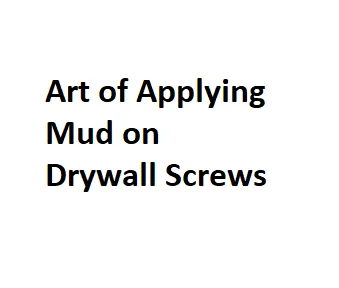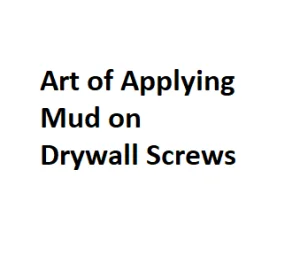When it comes to achieving a flawless finish on your drywall, the devil is often in the details. One crucial step in the drywall finishing process is the application of joint compound, commonly referred to as mud, on the drywall screws. How many coats of mud should you apply to ensure a smooth and seamless surface? In this blog post, we’ll delve into the nuances of this often-overlooked aspect of drywall finishing.
Understanding Drywall Screws:
Drywall screws are an essential component of any drywall installation. They secure the drywall panels to the framing, creating a stable and even surface. However, the screws also leave behind small depressions or dimples in the drywall that need to be filled and smoothed out during the finishing process.
The Importance of Mud:
Mud, or joint compound, is a thick substance used to cover seams, joints, and imperfections in the drywall. It’s a versatile material that comes in various forms, including pre-mixed and powdered versions. Applying mud to drywall screws is crucial for achieving a seamless and professional-looking finish.
Determining the Number of Coats:
The number of coats of mud needed for drywall screws depends on the specific requirements of your project and the desired level of smoothness. Generally, a three-coat process is common in the industry, but variations may be necessary based on the type of joint compound used and the skill level of the person applying it.
- First Coat – Embedding the Tape:
- The initial coat is often called the taping coat. It involves embedding drywall tape over the joints and screws. This coat is meant to create a strong foundation for the subsequent layers of mud.
- Second Coat – Building Thickness:
- The second coat is about building up the thickness of the mud to cover the tape and fill the depressions around the screws. This coat is crucial for achieving a smooth, even surface. It’s essential to feather the edges to avoid noticeable seams.
- Third Coat – Final Smoothing:
- The final coat is all about achieving a flawless finish. This coat is thinner, and the goal is to feather the edges even more, blending them seamlessly into the surrounding drywall. Sanding may be required between coats to achieve a perfectly smooth surface.
Tips for a Professional Finish:
- Consistency is Key: Ensure that the consistency of the mud is uniform for each coat.
- Feathering Edges: Pay attention to feathering the edges of each coat to avoid visible seams or lines.
- Sanding Between Coats: Lightly sanding between coats can help achieve a smoother finish.
Additional Considerations for a Flawless Finish:
- Drying Time:
- Allow each coat of mud to dry completely before applying the next one. Rushing this step can lead to imperfections and compromises the overall quality of the finish. Follow the manufacturer’s recommendations for drying times, and consider environmental factors such as temperature and humidity.
- Quality of Materials:
- Invest in high-quality joint compound and drywall tape. The quality of your materials can significantly impact the ease of application and the final result. Cheaper compounds may shrink or crack, leading to additional work and potential rework.
- Tool Selection:
- Use the right tools for each stage of the process. Taping knives, mud pans, and corner tools all play a role in achieving a professional finish. Clean your tools thoroughly between coats to ensure a smooth application.
- Sand with Care:
- Sanding is a critical step in achieving a smooth surface, but it requires a delicate touch. Use fine-grit sandpaper to avoid removing too much material and creating uneven surfaces. Sanding also helps blend the edges of each coat for a seamless look.
- Priming Before Painting:
- After the final coat has dried and been sanded, it’s advisable to apply a coat of primer before painting. Primer helps create a uniform surface, improves paint adhesion, and enhances the final appearance of the painted walls.
- Skill and Technique:
- Achieving a flawless finish takes practice. If you’re new to drywall finishing, consider starting on a small, less visible area to hone your skills before tackling more prominent sections. Pay attention to your technique and seek advice from experienced professionals if needed.
- Inspecting for Imperfections:
- Before proceeding to the painting stage, carefully inspect the entire surface for imperfections. Touch up any areas that require additional attention, and take the time to ensure the overall quality of the finish meets your standards.

